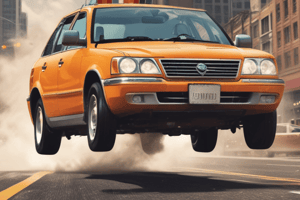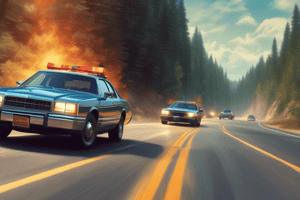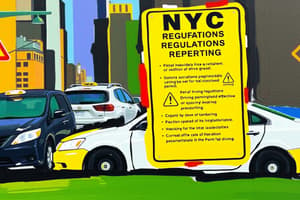Podcast
Questions and Answers
What is a crucial aspect to consider when monitoring your surroundings on the road?
What is a crucial aspect to consider when monitoring your surroundings on the road?
- Focusing solely on the vehicle in front of you
- Only watching for traffic lights and signs
- Extending your observation to include blind spots (correct)
- Maintaining a constant speed without checking mirrors
What position should a driver take when approaching an offside junction with limited visibility?
What position should a driver take when approaching an offside junction with limited visibility?
- Adopt a position that allows stopping or regaining the correct side. (correct)
- Accelerate to clear the junction quickly.
- Move to the left side of the road.
- Ignore the junction and continue cruising.
Which technique should be used to safely overtake another vehicle?
Which technique should be used to safely overtake another vehicle?
- Accelerate sharply to overtake quickly
- Wait for a clear signal from the other driver
- Observe your surroundings and anticipate other drivers' movements (correct)
- Always stay in the left lane for safety
When interpreting other drivers' signals, what should a police driver be cautious of when a vehicle flashes its headlights?
When interpreting other drivers' signals, what should a police driver be cautious of when a vehicle flashes its headlights?
When is it important to check your speed while driving?
When is it important to check your speed while driving?
What should you do when you see heavy goods vehicles on your left during a bend?
What should you do when you see heavy goods vehicles on your left during a bend?
What is a common mistake drivers make before emerging from a junction?
What is a common mistake drivers make before emerging from a junction?
In what situation should police drivers particularly reduce speed?
In what situation should police drivers particularly reduce speed?
How often should you scan your mirrors while on the road?
How often should you scan your mirrors while on the road?
What hazard is present when many vehicles are stationary at an incident?
What hazard is present when many vehicles are stationary at an incident?
What characterizes effective signaling practices while driving?
What characterizes effective signaling practices while driving?
What should be included in your observation strategy when planning to overtake?
What should be included in your observation strategy when planning to overtake?
How should a police driver approach an offsite junction to avoid accidents?
How should a police driver approach an offsite junction to avoid accidents?
Which practice enhances lane discipline on the motorway?
Which practice enhances lane discipline on the motorway?
What should a police driver assume regarding other drivers at an offside junction?
What should a police driver assume regarding other drivers at an offside junction?
What is a poor practice to avoid when dealing with flashing headlights from other vehicles?
What is a poor practice to avoid when dealing with flashing headlights from other vehicles?
What should always be prioritized during an emergency response?
What should always be prioritized during an emergency response?
When approaching traffic lights, what should be done if the light is red?
When approaching traffic lights, what should be done if the light is red?
What is the best practice when positioning yourself near a pedestrian crossing?
What is the best practice when positioning yourself near a pedestrian crossing?
What should be considered when contravening keep left/right signs?
What should be considered when contravening keep left/right signs?
What must be included in the risk assessment when approaching traffic lights?
What must be included in the risk assessment when approaching traffic lights?
What is a suitable method for ensuring visibility to other road users during daylight?
What is a suitable method for ensuring visibility to other road users during daylight?
How should one respond when another emergency vehicle enters an intersection using their exemption?
How should one respond when another emergency vehicle enters an intersection using their exemption?
What is a critical action when encountering a parked vehicle while driving at speed?
What is a critical action when encountering a parked vehicle while driving at speed?
Flashcards are hidden until you start studying
Study Notes
Emergency Response Driving
- Never compromise safety for time during an emergency response. It is better to arrive later than not at all.
- Inappropriate speed or misuse of exemptions can negatively impact public perception.
- When approaching red traffic light signals, treat them as stop or give way signs.
- Gather information about the road layout and consider other road users’ movements.
- Be aware of the green phase of the traffic light signals and ensure you can stop if necessary.
- On the approach to traffic lights, select the least obstructed path and make yourself as visible as possible to other road users.
- Where a pedestrian has moved onto the crossing, slow down to avoid intimidating them.
- When contravening keep left/right signs, be aware of additional hazards.
- During daylight, use flashing headlights or white LED units as visual warnings to other road users.
- Be vigilant for vehicles emerging from nearside junctions.
- Take up a position that allows for stopping or regaining the correct side of the road on the approach to offside junctions.
- Never assume that the driver of a vehicle waiting to emerge will look to the left before entering the road.
- Be cautious when a driver flashes their headlights as it may mean they intend to give way to multiple vehicles.
- Police drivers may become distracted searching for the exact location of an incident, increasing the risk of an incident.
- Drivers who have been stationary for some time may try to do a U-turn or leave their vehicle.
- Pedestrians may walk between stationary vehicles.
- Monitor for opportunities to overtake and match your speed of approach.
- Make allowances for additional hazards presented by lane closures and motorway junctions.
Observation and Anticipation
- Scan ahead, to the sides and to the rear frequently and thoroughly.
- Use your mirrors regularly to know what is happening behind you.
- Be aware of your own and other drivers' blind spots.
- Observe what is happening in those areas.
- Monitor your vehicle’s instruments and listen closely to the engine and tires.
- Check your speed regularly.
- Spot warning signs to predict when other drivers are about to change lanes.
- Use anticipation to help plan your route.
- Scan as far as the road horizon, front, back, and sides.
- Think carefully before overtaking on left-hand bends where there are heavy or large goods vehicles.
- Be mindful that a vehicle may be hidden between heavy goods vehicles and could suddenly pull out.
Studying That Suits You
Use AI to generate personalized quizzes and flashcards to suit your learning preferences.




